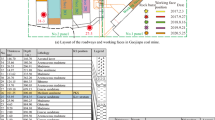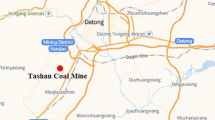Abstract
In view of the serious damage of roadway and the severe roof weighting of the 3302 working face, microseismic monitoring and surrounding rock displacement monitoring system were used to conduct on-line in-situ monitoring. In this paper, the energy distribution and microseismic event distribution of stope in the primary impact stage and the “square” stage (The working face is pushed to the stage where the strike length of the mined-out area is equal to the dip length, i.e., the stage of “square” of the working face.) are studied. On this basis, the deformation and failure law of the roadways is analyzed. Furthermore, the breaking regularity of multiple thick and hard strata with fully mechanized top-coal caving is obtained. Due to the high span of the fully mechanized caving face, the failure region of the overlying strata expands. As the fracture of the 3rd hard layer, the rotation and deformation of the upper rocks expand. With the periodic fracture of the 3rd hard layer, the hanging area of the 6th hard rock layer increases, which finally leads to its fracture. The weighting of stope is severe during the “square” stage, which is recorded through field monitoring. Through the preliminary analysis, it is concluded that the fracture of the 3rd and the 6th hard stratum contribute to the severe weighting during the “squire” stage, which is easy to induce rock burst. Over the primary impact period, the occurrence of seismic events is frequent and the ground pressure is strong. The maximum approach between two sides of roadway is about 750 mm, and that between the top and bottom is 1300 mm. The periodic weighting of three different “source points” is analyzed by numerical simulation. It is found that the peak value of leading abutment pressure in “square” stage is 82.09 MPa. Finally, the high risk zone of rock burst is obtained, and the predictable “pressure relief zone” is determined, which provides an important reference value for the prevention of rock burst in multi-layer thick and hard rock strata in a super kilometer deep well.












Similar content being viewed by others
References
Cai MF (2020) Key theories and technologies for surrounding rock stability and ground control in deep mining. J Min Saf Eng 2(03):5–13
Jiang YD, Pan YS, Jiang FX et al (2014) State of the art review on mechanism and prevention of coal bumps in China. J China Coal Soc 39(02):205–213
Jiang JQ, Zang PP, Pan LY et al (2015a) Study on microseismic distribution characteristics of high-position and ultra thick hard overlying strata under repeated mining. Coal Sci Techno 43(1):21–24
Jiang JQ, Zang PP, Qin GP et al (2015b) Fracture laws of one-side mined high-position hard thick key strata and microseismic energy distribution. J Min Saf Eng 32(04):523–529
Jiang JQ, Zang PP, Pan LY et al (2015c) Study on micro-seismic distribution characteristics of high-position and ultra thick hard overlying strata under repeated mining. Coal Sci Technol 43(01):21–24
Jiao JK, Ju WJ, Wu YZ et al (2019) Multi-layer control technologies for surrounding rock stability of dynamic-loading rock burst roadway. Coal Sci Technol 47(12):10–17
Kang HP (2020) Invited editor of the album “Surrounding rock Control and Intelligent Mining Technology in A Kilometer-deep Mine.” J China Coal Soc 45(03):1211–1212
Kang HP, Jiang PF, Huang BX et al (2020) Roadway strata control technology by means of bolting-modification destressing in synergy in 1 000 m deep coal mines. J China Coal Soc 45(03):845–864
Li ZQ, Xue YG, Li SC et al (2020) Rock burst risk assessment in deep-buried underground caverns: a novel analysis method. Arab Geosci 13(11):1–11
Liu YT (2016) Study on prevention and control technology of rock burst on overburden working face of multi-layer thick and hard rock based on microseismic monitoring. Thesis, Shandong University of Science and Technology
Liu JH, Jiang X, Feng T (2010) Numerical simulation of abutment pressure distribution of C-shaped stope. Rock Soil Mech 31(12):4011–4015
Pan JF, Mao DB, Lan H et al (2013) Study status and prospects of mine pressure bumping control. Coal Sci Technol 41(6):21–25
Qin ZC, Wang TX (2004) Abutment pressure distribution and its transfer law in floor of deep isolated fully-mechanized mining faces using sublevel caving. Chin J Rock Mechan Eng 23(7):1127–1131
Qin ZC, Liu J, Wang SC et al (2015) Study on relationship between microseismic events and abutment pressure distribution in fully mechanized. Coal Technol 34(07):3–6
Qin ZC, Liu YT, Wang SC et al (2017) The study of motion regularity of overlying strata overdeep buried “dual hard” fully-mechanized workface based on Microseismic monitor. J Min Saf Eng 34(1):74–79
Qin ZC, Chen GB, Zang GH et al (2019) Test on the dynamic failure rules of coal-rock composites. Acta Geodyn Geomater 15(1):39–54
Ren FQ, Chang Y, He MC (2020) A systematic analysis method for failure mechanism under stress unloading conditions a case of rock burst. Environ Earth Sci 79(15):1–16
Shi H, Jiang FX (2009) The dynamic abutment pressure rule of overlying strata spatial structures at the phases sub-critical mining. J China Coal Soc 34(5):605–609
Wang DC (2015) Study on the evolution mechanism and control of surrounding rock deformation and failure in goaf roadway excavation in fully mechanized top-coal caving with a depth of 1000 meters. Thesis, Shandong university
Wang CD, Wang Q, Li SC et al (2015) Stress distribution characteristics of deep mine in fully-mechanized sublevel caving face based on microseismic and online stress monitoring system. J Min Saf Eng 32(03):382–388
Wasilewski S (2020) Gas-dynamic phenomena caused by rock mass tremors and rock bursts. Int J Min Sci Technol 30(3):413–420
Yang PJ, He Y, Guo WB (2013) Disaster-causing mechanism and control measures of extremely thick and hard magmatic rock above working face. J China Coal Soc 38(12):2106–2112
Zang H, Li GS, Jiang S (2018) Experimental study on the temporal and spatial evolution law of surrounding rock deformation and failure in super-kilometer deep roadway. J Exp Mech 33(06):979–986
Zhao CX, Li WP, Sun RH et al (2010) Deformation and failure characteristics of roof in superimposed mining of multiple coal seams under extremely thick igneous rock. Saf Coal Mines 41(09):119–122
Author information
Authors and Affiliations
Corresponding author
Ethics declarations
Conflict of of interest
The authors declare that there is no conflict of interest.
Additional information
Publisher's Note
Springer Nature remains neutral with regard to jurisdictional claims in published maps and institutional affiliations.
Rights and permissions
About this article
Cite this article
Qin, Z., Liu, L., Gao, B. et al. Study on Surrounding Rock Movement of Fully Mechanized Top-Coal Caving with Strong Impact Under Thick-Hard Strata. Geotech Geol Eng 39, 2727–2737 (2021). https://doi.org/10.1007/s10706-020-01653-3
Received:
Accepted:
Published:
Issue Date:
DOI: https://doi.org/10.1007/s10706-020-01653-3




